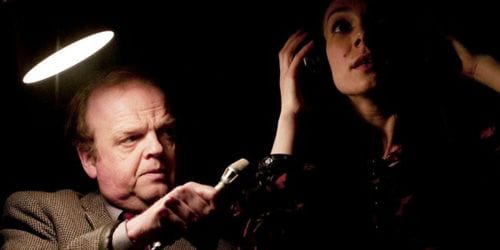
“Santini told me it was something ‘equestrian,'” says sound engineer Gilderoy (Toby Jones) at the outset of Berberian Sound Studio. He’s recently arrived at the titular studio, where he’s agreed to mix a film for charismatic Italian director Santini (Antonio Mancino). It’s sometime during the mid-’70s, and the socially awkward Brit quickly discovers the project isn’t really the spaghetti Western he’d imagined when he was first offered the job. Instead, Gilderoy finds himself at the helm of the sound crew for The Equestrian Vortex, an Italian giallo film. It sounds like a challenge, and so Gilderoy agrees to stay on, unable to anticipate the descent into mystery, horror, and eroticism that follows.
Despite its centrality to the film, we never actually see any of the footage that comprises The Equestrian Vortex, aside from an opening titles sequence. Through the conversations among the post-production dub vocalists and Gilderoy’s overbearing supervisor, Francesco (Cosimo Fusco), we learn that the film within a film’s plot focuses on two young women at an equestrian boarding school who happen upon a den of putrefying witch corpses. We also learn that the subsequent action mostly concerns the torture of the witches, which Gilderoy is assigned to animate via sound editing.
As it follows his efforts, Berberian Sound Studio is a dazzling display of the ingenuity of sound engineers. It is also an ode to the giallo tradition that slowly evolves into a surrealistic exploration of the line between art and life. In combining these interests, the movie both investigates and demonstrates how sounds severed from their sources produce viewers’ terror, using both Gilderoy’s engineered effects and the voices contributed by young, sexy Italian actors. With the exception of one man whose performance lasts for only a few seconds, all of these voice actors are women who either speak in frightened whispers or scream in outright terror.
When it’s not attending to these details of sound, however, Berberian Sound Studio isn’t much of a story. The set is a plain, dark soundstage that Gilderoy only leaves in order to go to bed. With the exception of a few scenes where Gilderoy and the other sound engineers are creating effects, the film is composed almost entirely of static shots that accentuate the actors’ stationary positions.
This means we don’t see the blood and guts that we usually associate with scary movies. By using only sound to convey the horror, director Peter Strickland demonstrates that violence isn’t just about gory imagery. He helps viewers to create their own scenes of terror. Hearing the sounds, we are able to imagine a landscape more terrifying than any that Berberian Sound Studio might have displayed, precisely because this landscape is ours.
Some of the most harrowing scenes in the film revolve around the sound effects for a sequence of torture scenes in The Equestrian Vortex. Many of these effects involve vegetables being smashed, slashed, ripped and otherwise destroyed. The physical reality of total vegetable destruction would seem humorous were it not for the way the sounds mesh with the action we are told is happening in the giallo film. Root vegetables having their greens ripped off no longer seem like innocuous sounds, but like human hair being ripped out. Such effects help us share in Gilderoy’s growing discomfort, as they are transformed into a kind of Freudian uncanny, sounds at once strange and familiar.
The human voice also takes on new dimensions during the studio recording process. As actors record their parts, their faces warp. When one older voice actress records her part, she opens her mouth extremely wide, hunches over, and gnashes her teeth as she speaks. The younger actresses become wide-eyed and grab onto each other, demonstrating physically the fear they are expressing vocally.
As long as the actors stick to their parts and don’t question the sounds they are asked to produce, their bodies and faces relax as soon as they leave the sound booth. However, not all of them are so lucky. Veronica (Susanna Capellaro) excels at reading her lines, but she has a throat problem that prevents her from screaming to Francesco’s satisfaction. (The film suggests the genesis of the problem can be traced to her questioning of the producer’s “vision.”) And when she steps out of the booth, Veronica is unable to distance herself from her work; she’s become too close to the terror she creates with her own voice.
When Veronica steps into the sound booth to talk to Gilderoy about her throat problem, we are treated to an inside view of this most disturbing effect. Their interaction seems to transform them, as both slowly morph into different characters. In her life outside of the booth, Veronica comes to embody the victim who dies in so many slasher films. And Gilderoy’s voice changes too, reflecting what he hears while at the sound studio. Both are reshaped by the sounds recorded and created during production of The Equestrian Vortex.
It takes a long time for the film to articulate the idea that sound manipulates anyone who listens to it, extending the story’s suspense. The final scenes in the movie seem like a marriage between hip, mid-’60s Hitchcock and late-’90s David Lynch. Colors swirl, worlds suddenly shift, the division between dreams and reality that became blurred in the sound booth is now erased by an onslaught of bright lights and fast cuts. The combination of the fast cuts, strobelights and shots of Gilderoy behaving in ways that he has not behaved throughout the film is overwhelming. By destroying the space between fantasy and reality, Berberian Sound Studio leaves viewers with the eerie feeling that everyday sounds are never going to seem normal again.

![Call for Papers: All Things Reconsidered [MUSIC] May-August 2024](https://www.popmatters.com/wp-content/uploads/2024/04/all-things-reconsidered-call-music-may-2024-720x380.jpg)



